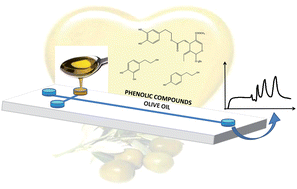Microchip electrophoresis with amperometric detection for a novel determination of phenolic compounds in olive oil†
Abstract
The relevance of the development of microchip electrophoresis applications in the field of

* Corresponding authors
a
Departamento de Química Analítica, Universidad de Extremadura, Spain
E-mail:
pgodoy@unex.es
Fax: +34 924274244
Tel: +34 924289375
b
Departamento de Química Física y Analítica, Universidad de Oviedo, Asturias, Spain
E-mail:
mtfernandeza@uniovi.es
Fax: +34 985103125
Tel: +34 985102968
The relevance of the development of microchip electrophoresis applications in the field of

 Please wait while we load your content...
Something went wrong. Try again?
Please wait while we load your content...
Something went wrong. Try again?
M. D. P. Godoy-Caballero, M. I. Acedo-Valenzuela, T. Galeano-Díaz, A. Costa-García and M. T. Fernández-Abedul, Analyst, 2012, 137, 5153 DOI: 10.1039/C2AN35844A
To request permission to reproduce material from this article, please go to the Copyright Clearance Center request page.
If you are an author contributing to an RSC publication, you do not need to request permission provided correct acknowledgement is given.
If you are the author of this article, you do not need to request permission to reproduce figures and diagrams provided correct acknowledgement is given. If you want to reproduce the whole article in a third-party publication (excluding your thesis/dissertation for which permission is not required) please go to the Copyright Clearance Center request page.
Read more about how to correctly acknowledge RSC content.
 Fetching data from CrossRef.
Fetching data from CrossRef.
This may take some time to load.
Loading related content
